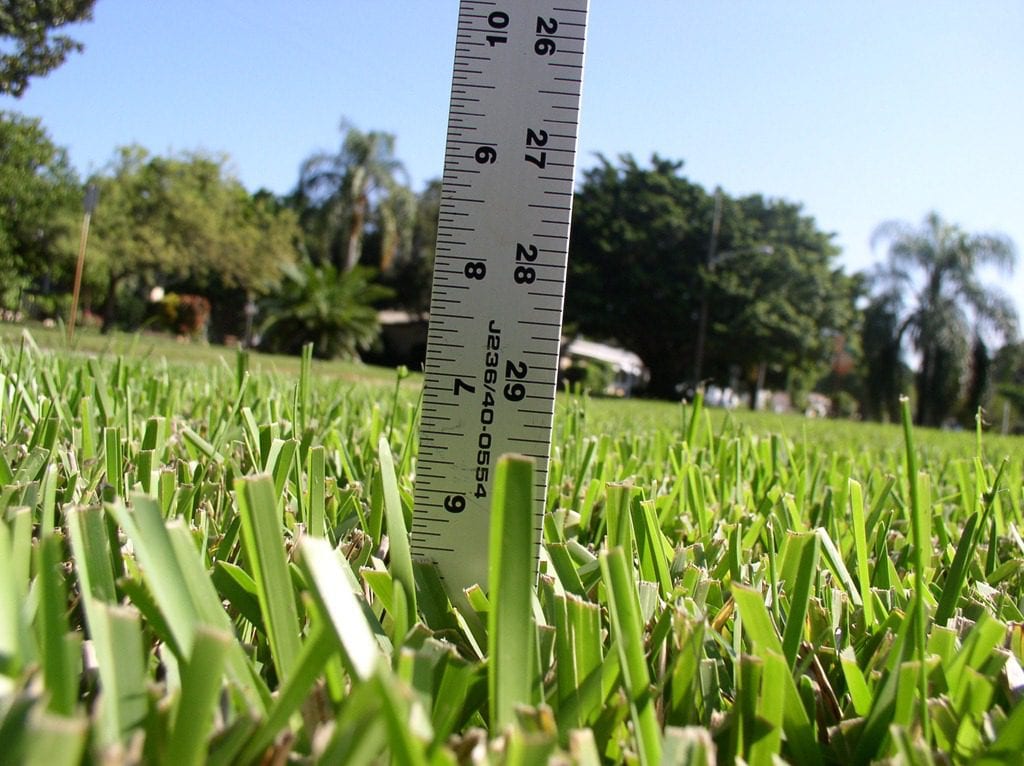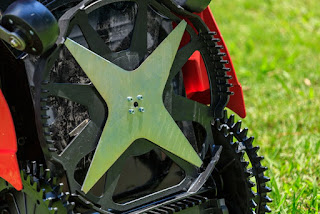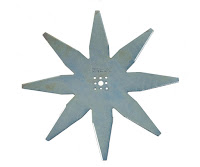Best Robot Mower Ambrogio, Advantage #1: The Blade
There is a lot of hype from marketing tactics by billion dollar companies touting the advantages of their robot mowers, but are they factual? How does one cut through the hype and get to the truth? Does the truth matter, as long as the lawn gets mowed? Yes.
I have been fortunate to work with the Ambrogio brand (formerly LawnBottⓇ in the USA, 2006-2016) since 2006. At the start of our business, there were only two other brands, one of the two is a multi-national company. Other than LawnBottⓇ, the major company was the only one that had a product that met the specifications for our lawn (3/4 acre w/30 degree slopes). What was the deciding factor? Why did we choose LawnBottⓇ over the billion dollar company? The blade.
Ambrogio Blade
Most Ambrogio robot mowers have a star-shaped reversible blade. It is available in two types, one with 4 razor sharp edges and one with 8 sharp edges. The blade typically lasts an entire season on a small lawn, or should be flipped mid-season for a large lawn.
Since the Ambrogio blade edge has 2-3" of sharpness vs less than an inch for the other brands, Ambrogio robot is far more efficient. It cuts a wider portion of grass as it travels vs. other brands. Ambrogio's blade can be sharpened when dull. It only needs to be replaced if it is bent, chipped or broken.
|
|
Typical Robot Mower Blades
The other brand we considered, along with most robot mowers today, uses small razor blades. First off, I could not understand how those tiny razor blades can even cut the grass, let alone stay sharp. Robot mowers originated from the Europe and have been designed for European grass. The blades of European grass are far narrower than North American grass, like 1mm or less. Considering grass types like St. Augustine that are not only six times wider, and at least twenty times stiffer (I made up those statistics), those little razor blades are no match. Seriously, though, St. Augustine grass blades are typically 1/4" wide. |
| St Augustine Grass |
Tiny razor blades do not sufficiently cut through wide/stiff North American grass blades in one swipe. The result is uneven cutting and vertical splitting of the grass blades, which is detrimental to grass health. And, since the tiny blades become dull much faster (typically within six weeks), there is a high risk of shredding the grass, too.
This Consumer Reports review of robot mowers comments on grass shredding. Their review is very negatively biased overall and unfair to robot mowers. I blame this on unfamiliarity and not actually owning one, which is the best way to understand the benefits. Advance to 1.11 to immediately see the comments about grass shredding.
Consumer Reports did not review LawnBottⓇ (the brand name for Ambrogio in 2015), nor did they indicate which robot shredded the grass or why. They indicate one major brand did not shred the grass, almost as if they were promoting the brand.
Here is the result of dull blades on grass; it is easy to see how detrimental this is.
 |
| Tearing/Splitting/Shredding due to Mowing with a Dull Blade |
Rotating vs. Fixed Blades
Back in 2006, the billion-dollar company's razor blades where fixed in place. Since then, they have made what they market as an enhancement: the blades rotate. Their marketing calls this a "safety feature". It is compared to a fixed blade in videos in an attempt to show a person won't be hurt by it. But they neglect to indicate that the fixed blade (such as the Ambrogio blade) is protected by bump sensors that cause the robot to turn away, and, just to be extra safe, a blade guard that covers the blade tips.
The truth about the small rotating blades? They get clogged with grass and often get stuck in a non-optimal position. The net result? Not only do you have to change the razor blades every six weeks to ensure they are sharp and do not shred your grass, but you also have to clean the grass out of the stuck blades. When the goal is to eliminate work, this is definitely not the way to go. And, rotating blades do not have enough force. Stiff St. Augustine grass blades push back on the rotating blades as hard as they can, as if to avoid getting cut at all. This will occur with weeds, too. The robot will leave weed stalks everywhere due to the blades not being forceful enough to cut them.
Landscapers Using Robot Mowers
There is a trend that landscapers are using robots to mow. They own the robots and charge customers monthly fees. In most cases, the robots stay on the owners property (vs. the landscaper dropping off the robots and picking them up).
First, by choosing a brand that uses the small razor blades, the landscaper has committed a minimum of 15 minutes per robot every six weeks to clean out the grass and change the blades. Typically, this equates to 1 hour of labor per season per robot, plus the blade cost (not including travel time). Bear in mind, the timing of the grass clogging the blades is not entirely predictable, thus a landscaper will have to address grass shredding complaints between planned visits.
Now let's scale this up to 1000 robots deployed: 1 hour per robot times 1000 robots = 10,000 hours. How many workers are required to change blades per season? Assume 26 weeks per season and a 40 hour work-week, it equates to 1040 hours per worker, let's round this to 1000 hours per worker per season for simplicity. Therefore, for every 1000 robots, ten workers are required **only for changing the blades**. This does not include their other work, i.e. trimming, blowing, bagging, planting, etc.
Now let's scale this up to 1000 robots deployed: 1 hour per robot times 1000 robots = 10,000 hours. How many workers are required to change blades per season? Assume 26 weeks per season and a 40 hour work-week, it equates to 1040 hours per worker, let's round this to 1000 hours per worker per season for simplicity. Therefore, for every 1000 robots, ten workers are required **only for changing the blades**. This does not include their other work, i.e. trimming, blowing, bagging, planting, etc.
On the other hand, Ambrogio's blade never clogs when grass is mowed dry, after the dew burns off. Ambrogio's blade can be sharpened over the winter, rather than during the season when time is tight. No extra labor is required to maintain the Ambrogio blade during the season.
The small razor blades do absolutely nothing for leaves. Ambrogio's blade, on the other hand, finely chops dry leaves, providing nutrients to the soil. Switching to the 8-edge blade in the Fall is a good idea. Landscapers can charge a small fee to change the blade to the "leaf blade" each Fall.
In conclusion, the Ambrogio robot blade is much closer to a traditional lawn mower's blade. It requires no maintenance during the season, unlike other robot mowers' blades. And, it is good at chopping leaves.
In conclusion, the Ambrogio robot blade is much closer to a traditional lawn mower's blade. It requires no maintenance during the season, unlike other robot mowers' blades. And, it is good at chopping leaves.
This is the second of eight articles my series, "Best Robot Mower, 7 Reasons to Choose Ambrogio". Subscribe via email or follow "TheRobotLadysBlog" to read them all.





Comments
Post a Comment